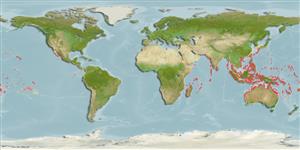Holothuroidea |
Synallactida |
Stichopodidae
Environment: milieu / climate zone / εύρος βάθους / distribution range
Οικολογία
Υφαλόφιλο(α); εύρος βάθους 0 - 15 m (Αναφ. 122). Tropical; 36°N - 35°S, 29°E - 134°W
Indo-Pacific, excluding Persian Gulf and Hawaii. Tropical and subtropical.
Length at first maturity / Μέγεθος / Weight / Age
Γεννητική Ωρίμανση: Lm ? range ? - ? cm Max length : 40.0 cm TL αρσενικό/απροσδιόριστο; (Αναφ. 75656); common length : 18.0 cm TL αρσενικό/απροσδιόριστο; (Αναφ. 122); μεγ. δημοσιευμένο βάρος: 1.5 kg (Αναφ. 75656)
Mean live weight: 100-400 g. Body-wall thickness 0.2 cm. Body firm, rigid with quadrangular section, flattened ventrally (trivium); body wall easily disintegrates outside sea water. Radii of bivium with characteristic double row of large papillae, each radius ending in a small red or orange papilla. Trivium delimited by characteristic double row of large papillae; stout podia arranged regularly on 3 radial bands, with 10 rows in the medio-ventral band and 5 in the lateral. Mouth ventral, surrounded by a row of papillae and 20 green, stout tentacles. Anus terminal. Calcareous ring with large radial pieces and narrow interradials. Cuvierian tubules absent. Cloaca large and greenish. Bivium dark green to black; trivium lighter. Spicules with very characteristic tables with a narrow disc showing 4 holes, bearing a spire generally ending in a moderately spiny crown; tables with larger disc and simpler crown also present; presence of many C-shaped spicules; rosettes absent; tables in dorsal with have a large multiperforated disc, bearing a large spire; ventral papillae with long, smooth rods; ventral podia with denticulate rods and large multiperforated plates; tentacles with smooth and granular rods.
Probably harvested in some artisanal fisheries of the area. Collected by hand at low tide, or by divers. The processed product is of low commercial value. A reef species mostly found in shallow areas from near the surface to a depth of 15 m (Ref. 122). Found on sandy areas (Ref. 115900) and generally occurs on reef flats and upper slopes. Populations reaching high densities on hard substrates, with a mean of around 0.04 per square meter. Shallow water populations are generally smaller in size than those found in deeper waters. Biology poorly known (Ref. 122).
Life cycle and mating behavior
Γεννητική Ωρίμανση | Αναπαραγωγή | Γεννοβολία | Eggs | Γονιμότητα | Larvae
Members of the class Holothuroidea are gonochoric and have only one gonad. Spawning and fertilization are both external and some exhibit brooding. Life cycle: Embryos develop into planktotrophic larvae (auricularia) then into doliolaria (barrel-shaped stage) which later metamorphose into juvenile sea cucumbers.
Conand, C. 1998 Holothurians (sea cucumbers, Class Holothuroidea). p. 1157-1190. In Carpenter, K.E. and V.H. Niem (eds.) FAO Species Identification Guide for Fishery Purposes. The Living Marine Resources of the Western Central Pacific. Vol. 2. Cephalopods, crustaceans, holothurians and sharks. FAO Rome. (Αναφ. 122)
IUCN Red List Status
(Αναφ. 130435: Version 2025-1)
CITES status (Αναφ. 108899)
Not Evaluated
Not Evaluated
Threat to humans
Harmless
Human uses
αλιεία: περιορισμένης εμπορικότητας
| FishSource |
Εργαλεία
Περισσότερες πληροφορίες
Τροφική ΟικολογίαFood items (preys)
Σύσταση δίαιτας
Κατανάλωση τροφής
Θηρευτές
Life cycleΑναπαραγωγήΓεννητική ΩρίμανσηΓονιμότηταΓεννοβολίαEggsEgg developmentLarvae PhysiologyΚατανάλωση οξυγόνου
Human RelatedStamps, coins, misc.
Διαδικτυακές πηγές
Estimates based on models
Preferred temperature
(Ref.
115969): 24.7 - 29.3, mean 28.4 (based on 3352 cells).
Ελαστικότητα
Υψηλό, ελάχιστος χρόνος για διπλασιασμό πληθυσμού < 15 μήνες (K=0.45).
Fishing Vulnerability
Moderate vulnerability (36 of 100).
Price category
Unknown.
